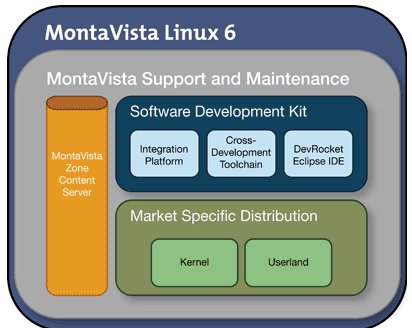MontaVista spins Linux development platform for Cortex-A9
Jun 23, 2010 — by Eric Brown — from the LinuxDevices Archive — viewsMontaVista Software, LLC, announced the availability of what's claimed to be the first commercial Linux distribution and toolchain optimized for ARM Cortex-A9 processors. Offered as a market specific distribution (MSD) package for MontaVista Linux 6 (MVL6), the software includes a toolchain optimized for the multicore-enabled Cortex-A9 architecture, says the Cavium subsidiary.
MontaVista offered few details about the Cortex-A9 MSD except to say it is based on MontaVista's latest MontaVista Linux 6 (MVL6), and is optimized for Cortex-A9 features including graphics, audio, multimedia, and "basic networking features." Target applications include set-top boxes, DTVs, and printers in the networking, automotive, industrial automation, mobile, and consumer markets, says MontaVista.
MVL6 and MSDs
Released last September, MontaVista Linux 6 (MVL6) was something of a radical departure for the decade-old development framework, adding a new build engine (MontaVista Integration Platform) that adopts support for an open source bitbake recipe format. Also new is a content server called MontaVista Zone.
The biggest change, however, was the structural relaunch of the product in the form of specific Market Specific Distributions tailored for different architectures, specific processors, and targeted usage scenarios. Built on a common framework, but optimized for different platforms, the MSDs are said to be feature-compatible with the semiconductor vendors' Linux technology. Each MSD is comprised of an embedded Linux kernel, appropriate device drivers, and userland code.

MontaVista Linux 6 architecture
MSDs are also available for Intel's "Greencity" (Core 2 Quad/Nehalem) and Atom Z530 (Moblin) platforms, as well as Texas Instruments' ARM-based OMAPL128/L127, and Cortex-A8-based OMAP3430 (Zoom2), and OMAP3530 (BeagleBoard).
A pioneer in the embedded Linux business, MontaVista last summer celebrated its tenth anniversary of selling Linux tools and distributions. The company was acquired by semiconductor vendor Cavium in December. In April of this year, MontaVista announced a "rapid deployment program" offering software reference platforms for Android development on TI's OMAP3x and MIPS Technologies' MIPS processors.
Cortex-A9 background
MontaVista's announcement of the new MSD did not say which specific system-on-chips (SoCs) it will be supporting. Two likely candidates include the first ARM Cortex-A9-based processor to be announced, the Texas Instruments OMAP4, scheduled for volume production in the second half of this year, as well as Nvidia's Tegra 250 (or "Tegra 2"), which is already appearing in a number of consumer tablet designs, most of them running Android.
In February, NEC Electronics announced a Cortex-A9 version of its Linux-ready EMMA Mobile series of multimedia SoCs called the EMMA Mobile/EV. The SoC can play 1080p video, and comes in single-core (EV1) and dual-core (EV2) versions, the latter equipped with 2D/3D graphics acceleration.
Earlier this month, STMicroelectronics announced a new line of SPEAr1300 SoCs that will employ dual Cortex-A9 cores. The product line will support fully symmetrical operation at up to 600MHz/core, include a DDR3 memory interface, and be manufactured using 55nm HCMOS (high speed CMOS) technology.
Additional semiconductor manufacturers preparing Cortex-A9 SoCs include ST-Ericsson and NXP.
Announced in Oct. 2007, ARM's Cortex-A9 core is a multicore capable variation on the earlier Cortex-A8 core, which is widely used in smartphones and other embedded devices. Like the Cortex-A8, it supports a dual-issue, superscalar pipeline that can execute multiple instructions simultaneously. The faster Cortex-A9 provides clock speeds over 1GHz, and boasts performance of around 2,000 Dhrystone MIPS. The A9 also adds support for ARM's MPCore interconnect technology.
Stated Ian Drew, EVP of marketing at ARM, "The combination of MontaVista Linux 6 and the high-performance, low-power technology of the Cortex-A9 processor enables ARM Partners to quickly begin development of scalable, performance optimized next-generation Digital Media devices."
Stated Dan Cauchy, VP of marketing, MontaVista, "MVL6 is the first commercial Linux available for the ARM Cortex-A9. Fully optimized for the Cortex-A9, our customers will enjoy the benefits of a distribution and toolchain developed specifically for their platform."
Availability
The Cortex-A9 MontaVista Linux MSD is available now, says MontaVista. More information may be found here, and specific SoC support should eventually show up on MontaVista's MSD development board page, here.
This article was originally published on LinuxDevices.com and has been donated to the open source community by QuinStreet Inc. Please visit LinuxToday.com for up-to-date news and articles about Linux and open source.